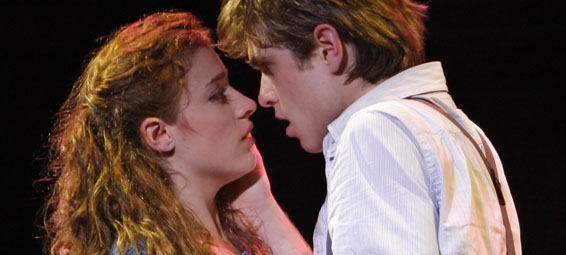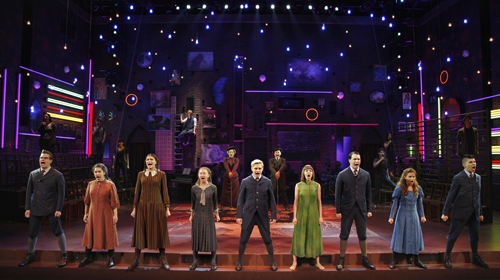What would happen if no one ever told children about the birds and the bees? What would happen when puberty hits and their hormones go haywire and their bodies betray them? That’s the premise of Spring Awakening, the winner of the 2007 Tony for Best Musical and latest installment of the Lexus Broadway series at the Winspear. Based on a play so controversial it was banned from the day it was written, this musical braves the subject of budding sexuality and the terror it brings with the energy and emotion of rock music. This is an evening of sex and consequences you’ll never forget. It should be required viewing for parents to help them remember what it was really like in the “best days of their life.”
Steven Sater borrowed this dark idea from Frank Wedekind’s play of the same name when he wrote the book and lyrics for which he won Tonys as well. Interestingly, the musicals book is set squarely in the 1890’s, the strict mores reflected in the stilted syntax, but the lyrics are in the contemporary voice of the modern teen– limited vocabulary straining against limitless emotion. Employed exquisitely in the sometimes spare and sometime rich orchestrations by Duncan Sheik, the songs give us complete windows into aspects of the adolescent paradox in general and the character’s dilemma in particular. Make no mistake, this is adolescent sturm und drang. They are cramped, yet long for contact, claustrophobic even while alone and made paranoid by the supreme injustice of their body’s betrayal. All these issues are sharpened knife-like by the discovery of their sexuality. The fact, that the songs so well encapsulate all of this is what makes the simple set possible.
Christine Jones has created a space reminiscent of a Deep Ellum open mic in the old days of Dave’s Art and Pawn. The red brick wall adorned with an eclectic assortment of images symbolic to somebody (images from the songs). There are banks of chairs flanking the playing area and the house band—a likely holdover from early workshops that captured the imagination of the creators and couldn’t be improved upon. The gimmick pays off at several points. The cast and a few brave audience members sitting on stage appear to be mourners and members of the jury, complicit and complacent as they witness the catastrophe before them.
The show opens with a young girl, Wendela, examining herself in the mirror of the audience. Her absent-minded movements tracing her form become dance gestures later. She sings an ode to her mother who has not prepared her for her own blooming. What followed in the Broadway production was a faithfully painful scene of a mother’s failure to explain the birds and the bees to a daughter who is in desperate need of knowing. Unfortunately, Angela Reed, who plays all adult women, has turned this scene toward the comical. What is lost is the pit of your stomach foreboding as you see just how in the dark this girl is, how culpable her mother is and by creative casting extension all adults. From the outset, you should know this world is headed for trouble of the worst kind and where the blame lies. Softening the opening scene with musical comedy muddies the tone and puts “melo” in the drama.
The girls are in the dark, for sure, but the boys are no better off. In their first scene, we glimpse the 1890’s Latin class rigidly reciting their Aeneid. In a number that surely won Bill T. Jones the choreography Tony, the rigid discipline of technical recitation forms not only the rhythm on which he builds the dance but also informs the gestures. Perfect choral movements and tight individual flourishes start amongst the school chairs, develop outward in grids and finally explode in punk rock leaps, all affected by the structure against which they rebel. It’s Angus Young meets Ann Bogart, and it is the best integration of music and choreography of the evening. It is only the third song. A similar collection of leaps and tucks serves to perfectly elucidate the second act teen anthem that I will refer to as Fotally Tucked in consideration of our more delicate readers. It is the most evocative choreography in the play. To give you an idea of how powerful, it is said that we sing when words can no longer convey the emotion and dance when singing isn’t enough. Well, at the height of the song even the words break down to simply, “Blah blah blah-blah blah blah blah!” In this moment of music, dance and broken lyric, you get an emotional catharsis that can only come from rock and roll and the age it was meant for.
Of course, there are low points to the choreography as well. For instance, what starts as Wendela’s absent-minded tracing of her body in the opening number morphs later into something like Madonna’s “Vogue.” It’s apropos of nothing and even less moving. As the show moves along they seem to learn the error their ways and end up just bringing mic stands out for some of the most powerful numbers. Basically, they run up the white flag to the music and say we can’t do any better with the song than just singing it. They’re right.
The show has transferred to capable hands. Christy Altomare has taken the reigns of Wendela and steers her in the same direction as her Broadway precursor confidently. Jake Epstein doesn’t capture Jonathon Groff’s sense of foreboding in his creation of Melchior, though. Maybe it’s his behind the beat style or his congenial smile. In either case, Groff’s Melchior was more awestruck at his discoveries. Finally, Taylor Trensch is entrusted with the Tony-winning, show-stealing role of Moritz, the bad luck friend who is least able to deal with his changing world. His voice is up to the task but his intensity is not. When he duets with Steffi D, playing Ilse, she schools the schoolboy. She GETS rock. Her voice equals her presence. Where most of the cast whispers their pop vocals into their headsets, her voice punches as if the microphone is in her way and this close to getting a beating.
Every parent should be required to see this – not because it’s perfect, but because it is not. It is bombastic in its bias and shares rock and roll’s urgency to deliver its message of the misunderstood. The magic of the piece is that it shows the world as the adolescent sees it – something that adult amnesia protects parents from. They need reminding. Sure it’s unfair to compare modern parents to the twisted adults represented here by two actors, but even in our instant access to info iPhone world adolescents can feel just as ill-informed as these kids in their knickers and jumpers gasping for guidance. Two actors can represent all adult men and women because when puberty hits, all adults are suddenly the same: they’re on the other side of the hormone divide. And they don’t seem to be any more forthcoming than any given adult from 1890. Take the time to take your teen and start “the talk.”






